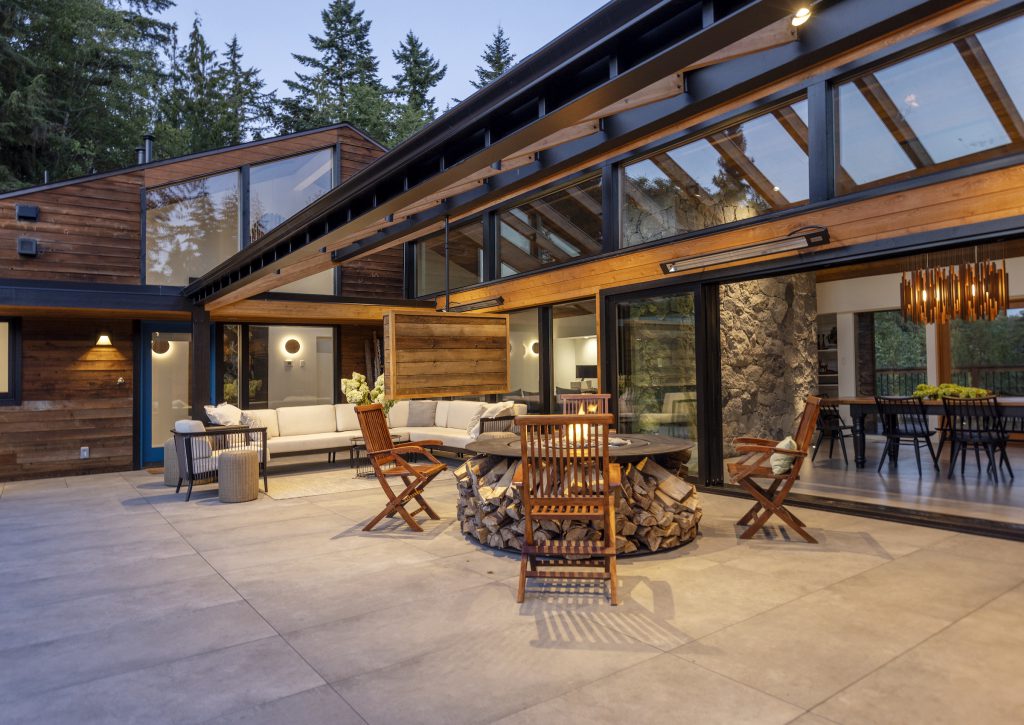
Opinion: HAVAN’s Ron Rapp looks at ways to bring the inside, out.

The outdoor living room trend is stronger than ever, says HAVAN CEO, Ron Rapp. Builder: My House Design/Build/Team
Connecting with nature is a quintessential part of living on the West Coast, so it’s no surprise the outdoor living room continues to be on trend in 2023. Amplified through the pandemic when our attention was centred on making the most of our homes and adjacent outdoor spaces, homeowners are bringing the inside, out.
Outdoor living trends include overhead structures providing shade to reduce solar gain, weather protection, and year-round use with outdoor heaters, fire pits, and lighting. Outdoor kitchens that withstand the elements feature cabinetry, sinks, cooking equipment, barbecues and even dishwashers.
Integrated raised planters for ornamental plants or home gardens and seating arrangements, as well as hot tubs, spas, saunas and plunge pools, are also having a moment, along with the backyard office/shed.
Outdoor living spaces can offer endless possibilities, but design considerations regarding elevation, orientation to the sun, square footage, and neighbouring properties must be considered. Typically, homeowners tend to leave outdoor spaces at or near the bottom of their list, but with proper planning in conjunction with the builder, designer, landscape architect and professional landscape contractor, they can transform your outdoor wish list into reality.
Professionals will create a plan to balance spaces from the inside out, ensuring flow, consideration of the home’s architecture, integration of structural elements, and material choices while accounting for timing, sequence, the environment, maintenance, and overall costs. The same way we apportion space within a home to serve our needs and lifestyles, when designing outdoor spaces, we also need to consider how and what it will be used for and the relationship to adjacent indoor spaces.
In addition to the design, exterior living areas or landscape projects must address regulations, bylaws, and permits associated with structural elements such as pergolas or decks directly connected to the home. And the safe routing and approvals required for the provision of electrical power for lighting and appliances, as well as water and gas lines needed to support the design and décor concepts. Duly inspected and approved service connections installed in a proper sequence will help avoid conflicts with other stages of site construction, saving on cost and ensuring safety inside and out.
Permits are also required to protect or remove trees. Just because a tree is on your property does not give you the right to cut it down. Speaking with HAVAN member Victor Kulla of Huckleberry Landscape Design, he points out that existing or newly planted trees play a critical role in the design and feel of our outdoor spaces. Placed in the right location, even a single tree can provide privacy and shade, reducing the surrounding temperature by a few degrees. Planting the wrong species in the wrong location can lead to poor growth and potential damage to the home, hard surfaces and other structures.
Kulla notes replacing lawn areas with ground cover is gaining broader acceptance as it requires less water and maintenance and can provide a greening and cooling effect. He also recommends working with native plant species where possible to increase survivability, reduce maintenance, and reduce water consumption supporting municipal water restrictions while still offering a variety of colours, scents and textures for year-round appeal.
In addition to these considerations, driveways, utility lines above and below ground, stormwater management systems, existing structures, trees and their root systems impact how builders can efficiently and effectively undertake construction and move around the site with new builds or major renovations.
Experienced professionals can also provide “a plan” that can be installed in phases and adapt to your budget constraints or changing lifestyle requirements. Good communication, pre-planning, sound design and working with a team of experienced professionals will account for ready and practical access, direct and visual connection to adjacent indoor spaces, elevation differences, topography, existing features like trees and structures, exposure to sunlight, and the uses and experiences desired.
Outdoor living has the potential to enhance and extend the enjoyment and value of your home. With thoughtful planning, the creative use of native and ornamental plants, careful material selection, structures, screens and existing features can combine to provide a sanctuary from the hectic pace of our daily lives.
Ron Rapp is CEO of Homebuilders Association Vancouver. He can be reached at ron@havan.ca and Twitter@HAVAN_CEO.
https://vancouversun.com/homes/outdoor-living-spaces-offer-possibilities











